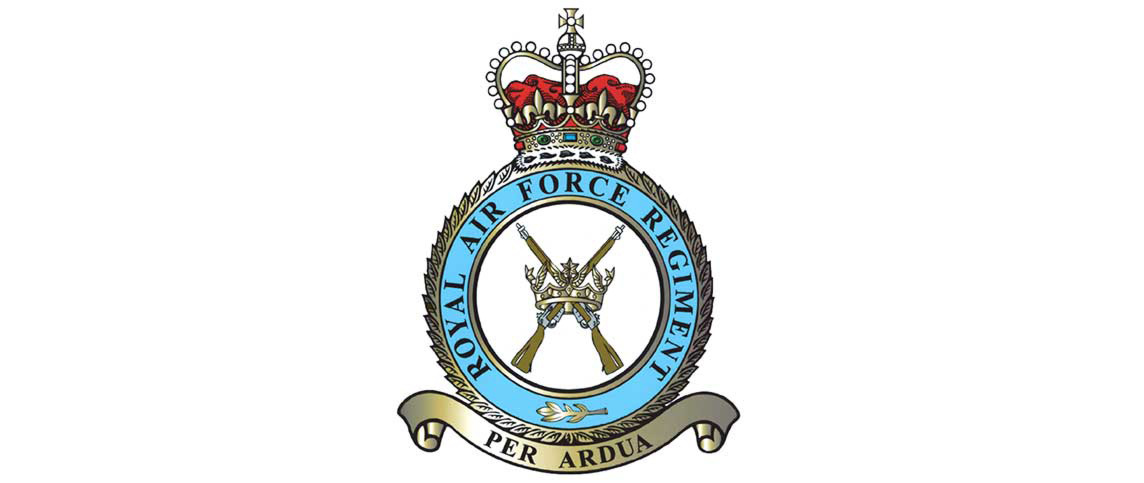The Royal Air Force (RAF) Regiment
IN THE BEGINNING
The RAF Regiment is to the RAF, what the Royal Marines are to the Royal Navy; it is the ground fighting force that enables its parent service to operate effectively from a safe environment. The RAF Regiment has its roots in the RAF Armoured Car Squadrons that protected the RAF in its Air Control role of preserving the peace of the Middle East Mandate after the Great War of 1914-18. Nos 1 and 2 Armoured Car Squadrons are direct ancestors of today’s Nos 1 and II Squadrons RAF Regiment.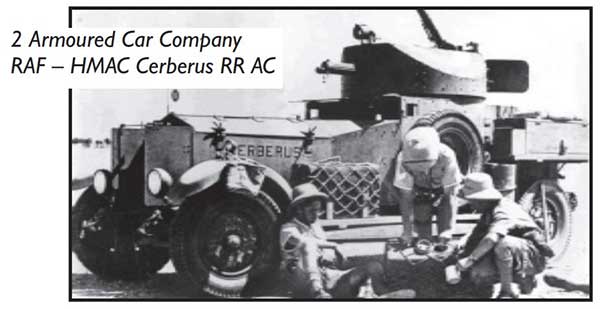 2 Armoured Car Company Royal Air Force
2 Armoured Car Company Royal Air Force
In the post-war years, the fledgling RAF operated in relatively benign environments; however, the German shock tactics developed in the Spanish Civil War and in the approach to World War II, coupled with the British Army’s focus on rebuilding itself after the debacle of the British Expeditionary Force’s evacuation from Dunkirk in 1940, forced a different and radical review of RAF ground defence. A specialist RAF ‘Ground Gunner’ organization was established but its ad hoc and ill-defined tactics were no match for the enemy’s capabilities.
Prime Minister Winston S Churchill observed, in 1941 – following the Battle of Crete debacle - that, ‘Every Airfield should be a stronghold of fighting air-groundmen, and not the abode of uniformed civilians in the prime of life protected by detachments of soldiers’. Recognizing that the RAF needed its own specialist ground defence force, the RAF Regiment was formed by the Royal Warrant of HM King George VI in February 1942, as a unique Corps within the RAF. While the strategic function of the Corps was to be inherently defensive, it was deemed essential that it should be trained to act tactically on the offensive and that its title should be one which will foster a fighting spirit and high morale and not lay emphasis on the defensive role.Its initial tasks were essentially the ground and low-level air defence of the UK-based airfields facing imminent Nazi invasion. However, the role expanded rapidly to include more offensive action as the direct invasion threat to the UK mainland diminished and the focus moved to mainland Europe, the Middle East and - with the entry of Japan int the war in December 1941 - the Far East.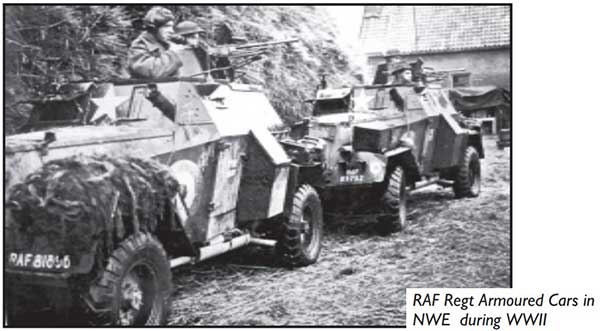 RAF Regiment Armoured Cars During WWII
RAF Regiment Armoured Cars During WWII
THE POST-WAR YEARS
The Regiment served in every theatre of the war and quickly gained a reputation as a highly effective fighting force. It fought in the Battle of El Alamein with the British 8th Army and was present at the final victory over the Axis forces in North Africa. The Regiment then went on to serve with distinction in Italy, Greece and Yugoslavia. It was involved fully in the D-Day landings in June 1944, where the Regiment fought alongside - and frequently in advance of - its sister Army units, providing route defence and securing German airfields and equipment before they could be destroyed. It also comprised the first Allied forces to enter Denmark. The Regiment also fought a highly successful campaign in Burma and was responsible for maintaining the security of the forward jungle airstrips that were crucial to the air-logistics support of the land forces in the fight against Japanese forces. At its height, the Regiment comprised some 85,000 personnel, but at the end of World War II, its strength was drastically reduced by the wholesale demobilisation of the Wartime armed forces.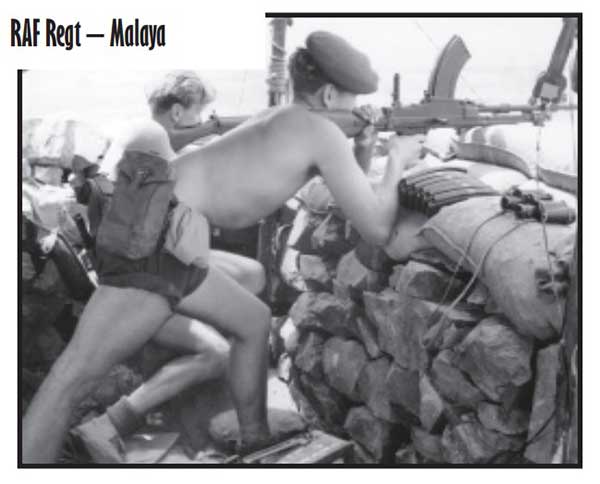 RAF Regiment in Malaya
RAF Regiment in Malaya
In the post war years, despite frequent UK Government and budget threats to its very existence, the Regiment continued to provide effective defence of RAF assets worldwide. It played a significant part in the RAF Levies (Iraq), RAF Regiment (Malaya) and the Aden Protectorate Levies, which it commanded for a 10-year period. It provided field forces in support of the Army continuously during OPERATION BANNER in Northern Ireland (1969-2007) and deployed its Tigercat surface-to-air missile systems to British Honduras (now Belize), Central America, when Guatemala threatened to invade the British Dependency in 1972 and again in 1978. In 1982, No.63 Squadron RAF Regiment, armed with the Rapier short-range air defence system, deployed with 5 Infantry Brigade to defend the RAF’s Harrier Force - at Port San Carlos and then Port Stanley - against Argentinean air attack during the Falklands Conflict. Units of the RAF Regiment remained in the Falklands providing continuous, 24-hour air defence of the RAF airfields there for the following 24 years.
The RAF Regiment relinquished its air defence role in 2008, leaving it with its mainstay field squadrons in the infantry role. One unit - No II Squadron RAF Regiment – has a fully-fledged parachute capability to enable it to secure hostile airfields in advance of the land forces. That Squadron is, currently, the only British unit to have parachuted into an active operational theatre - in Sierra Leone since the Suez Crisis in 1956. Another unit, The Queen’s Colour Squadron (No 63 Squadron RAF Regiment) is responsible for the custody and escort of The Queen’s Colour for the RAF in the UK. Although technically a RAF unit, it is commanded and manned by the RAF Regiment; it is dual-roled as a field squadron and has been deployed on operations in Cyprus, Iraq, the former Republic of Yugoslavia and Afghanistan.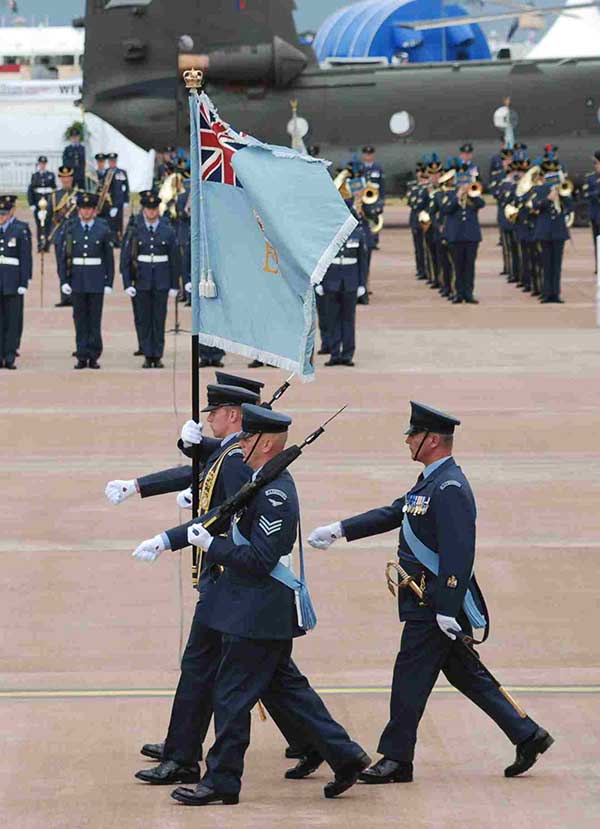 Queens Colour Presentation at RAF Fairford in 2008
Queens Colour Presentation at RAF Fairford in 2008
The RAF Regiment also deployed en masse to protect RAF assets during Gulf War 1, the Allied recapture of Kuwait, in 1991 and returned there in 1997 when Iraq once again threatened its neighbours. It was also fully involved in Gulf War II, the invasion of Iraq, and the United Nation’s counter-terroris operation in Afghanistan from 2002. Elsewhere, the RAF Regiment has also provided a significant number of officers in support of United Nations’ peace, support and peacekeeping operations; these have included Cyprus, Bosnia Herzegovina, Kosovo, Cambodia, Sierra Leone, former Soviet Union Republics and many others over several decades. The Regiment is also provides a combat element of the UK Special Forces Support Group and individual personnel in the Special Air Service; it has also participated in a highly effective Officer Exchange Programme with the USAF Combat Security Police and Security Force since 1965. On its formation, the home of the RAF Regiment was at Belton Park, Leicestershire, but it moved in 1946 to RAF Catterick, North Yorkshire, where it stayed until it transferred to its current location at RAF Honington, Suffolk, in 1994. The Corps was presented with its first Queen’s Colour by HM Queen Elizabeth II in 1953; since then, four other Queen’s Colours for the RAF Regiment have been presented, the last one - together with The Queen’s Colour for the RAF in the UK - at RAF Fairford in July 2008, celebrating the 90th Anniversary of the formation of the RAF. The Corps sets great store in the community of the Regimental Family. Military ethos, traditions and esprit de corps are viewed as powerful motivators and are emphasised throughout an individual’s time with the Corps and afterwards as a veteran. A competitive spirit is patently visible in all aspects of the RAF Regiment.
CORPS ORGANISATION
The Corps is commanded from Headquarters RAF Air Command at RAF High Wycombe in Buckinghamshire. At its head is the Commandant General, an Air Commodore. It is a diverse Regiment, since although the majority of its manpower is vested in the RAF’s Force Protection Force, many others occupy positions within the wider NATO, Ministry of Defence, Joint Service and RAF operations and training organizations. For example, the RAF Regiment is responsible for the organization and implementation of all RAF station and operational Force Protection training for the RAF. Additionally, it provides the command and core element to the Joint Service (JS) Chemical, Biological, Radiological and Nuclear (CBRN) Defence Centre at Winterbourne Gunner in Wiltshire, and a significant element of the JS CBRN Regiment at RAF Honington. It also provides other Corps assets in support of UK Special Forces.
The RAF Regiment was responsible for developing NATO’s Survive to Operate (STO) concept for its international air forces; the STO concept was later developed into NATO’s and the British Armed Forces’ Force Protection (FP) concept which provides a comprehensive and coordinated approach to the defence of military assets. The RAF Regiment is widely recognized as the world leader in specialist FP and CBRN operations.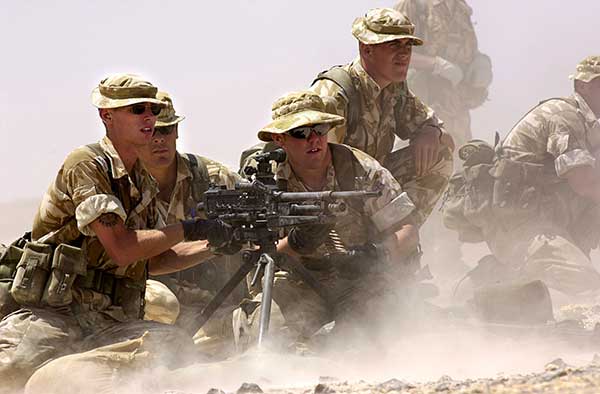 General Purpose Machine Gun in the Sustained Fire Role
General Purpose Machine Gun in the Sustained Fire Role
With the loss of the air defence role in 2008, the Regiment is now focussed mainly on providing its infantry capabilities. There are currently seven field squadrons (with an eighth in prospect), all under the operational command of a RAF Force Protection Wing Headquarters and supported by a commensurate number of Royal Auxiliary Air Force (RAuxAF) and RAuxAF Regiment units. Further manpower, equipment and unit enhancements to the Force are planned to cater for the Corps’ ongoing operational commitments in Iraq and Afghanistan.
The RAF Regiment, on operations, is primarily responsible for the ground defence of RAF facilities ‘outside of the wire’ and this role involves the active patrolling and ‘domination of ground’ out to a certain distance to deter and prevent hostile forces from launching direct or indirect attacks upon the airbase. Internal base defence is generally undertaken by the wider RAF contingent and the RAF Police, supported by the RAF Regiment. Regiment field squadrons are generally better equipped than their British Army counterparts, notably in the provision of integral indirect fire support (ie mortars) and CBRN areas. Of note, the RAF Regiment is, reputedly, the only force in the British Armed Forces to have been on uninterrupted operations since its inception in 1942.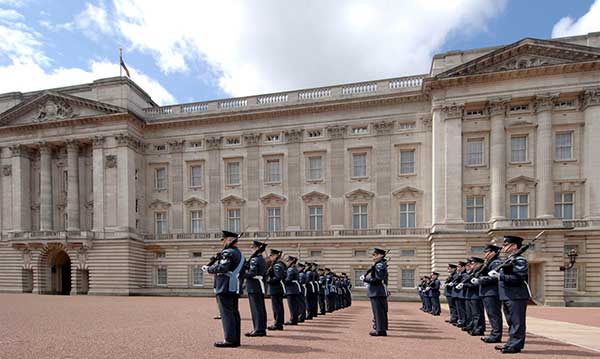 Queens Colour Squadron (No.63 Sqn RAF Regt.) on Parade at Buckingham Palace -2008
Queens Colour Squadron (No.63 Sqn RAF Regt.) on Parade at Buckingham Palace -2008
CEREMONIAL DUTIES
Another, more public, role of the RAF Regiment is providing the professional ceremonial support for the RAF. This role is undertaken primarily by The Queen’s Colour Squadron (No 63 Squadron RAF Regiment). With its origins in the RAF Regiment’s Demonstration Flight and then the RAF Drill Unit, The Queen’s Colour Squadron was formed on 1st November 1960 and has since gained a worldwide reputation for drill and ceremonial excellence. It represents the RAF at all major ceremonial occasions and, as mentioned earlier, is the Escort Squadron to The Queen’s Colour for the RAF in the UK, whenever it is paraded. The Squadron also provides Guards of Honour for visiting Heads of State and military dignitaries. It also has the honour, since 1943, of carrying out Public Duties on behalf of the RAF at Buckingham Palace, St James’ Palace, Windsor Castle and Edinburgh Castle on a regular basis. However, the Squadron is probably best known for its continuity drill displays, which have been performed before audiences throughout the world.
Continuity Drill – the execution of a complex series of drill movements covering foot and arms drill without orders – was pioneered by the RAF Regiment’s Demonstration Flight and began life as a training aid; it later evolved into a role for The Queen’s Colour Squadron. The displays require the Gunners to memorise several hundred consecutive drill movements, all of which are taken directly from the RAF Drill Manual; none are contrived merely to enhance a performance.
The Queen’s Colour Squadron currently holds the world record – certified by the Guinness Book of World Records – for completing the most rifle and foot drill movements in a 24-hour period.
INITIAL TRAINING
The RAF Regiment, in concert with British Army Infantry and Royal Marines, only accepts male candidates for service. If you aspire to join the RAF Regiment, you will have to undertake (for commissioned service as an officer) a Potential Regiment Officers’ Acquaintance Course – PROAC – or (for non-commissioned service as a Gunner) the Potential Gunners’Acquaintance Course – PGAC at RAF Honington. Organized through the Armed Forces’ Careers Information Offices, these three-day courses would assess your level of fitness and overall suitability for undergoing Regiment training.
For those successful PROAC candidates, initial officer training conducted at RAF College Cranwell would be a pre-cursor to undertaking the Junior Regiment Officers’ Course (JROC) but, for those passing the PGAC, initial RAF training is undertaken at RAF Honington before embarking on the professional Trainee Gunners’ Course. Both courses would teach you how to operate a variety of personal and section-level weapons, in a wide range of environments and climatic conditions. The training is tough because it has to be. Soon after graduation, you could find yourself in the thick of an engagement with enemy forces in a distant and hostile land; the RAF Regiment trains its people well and effectively to ensure that they have the best advantage in a conflict situation.
Those on the JROC also learn to be junior commanders, developing the necessary tactics to enable them to lead their men in combat situations from the outset of their careers. Those who make the grade at the end of the long and arduous courses have the honour of wearing the Corps’ coveted RAF Regiment shoulder ‘flash’. On completion of the basic RAF Regiment training, individuals will then progress to further training, including specialist communications and ‘close precision attack’ skills as a Sniper. After graduation, you would find yourself assigned to a RAF Regiment squadron with the prospect of deploying operationally within a short period of time. However, you would return to RAF Honington occasionally to complete further training.
The RAF Regiment is fiercely proud of its heritage and its reputation for its world-class Force Protection capabilities. Do you have what it takes to serve in the RAF Regiment? For more details contact your local Armed Forces’ Careers Information Office or go online at: https://www.raf.mod.uk for an interactive look at the Corps.
THE GUINNESS BOOK OF WORLD RECORDS
The Queens Colour Squadron appears in the Guinness Book of Records having completed over 2,700,000 foot and rifle drill movements in 23 hours and 55 minutes. This still stands as a record that, unsurprisingly, has not been challenged. 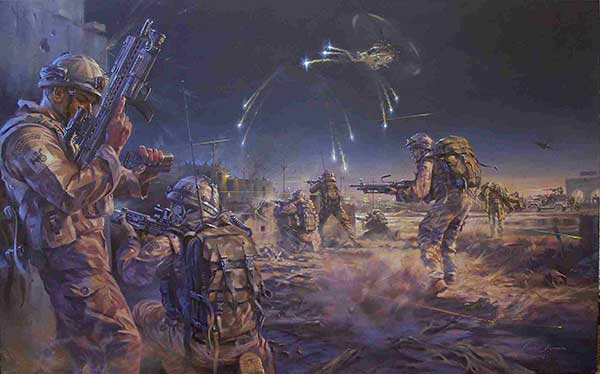 Picture of the Al Waki firefight in Basrah, Iraq in which Cpl David Hayden won the Military Cross
Picture of the Al Waki firefight in Basrah, Iraq in which Cpl David Hayden won the Military Cross

